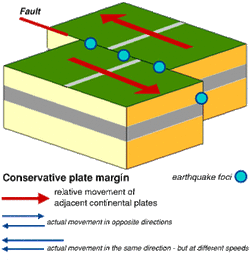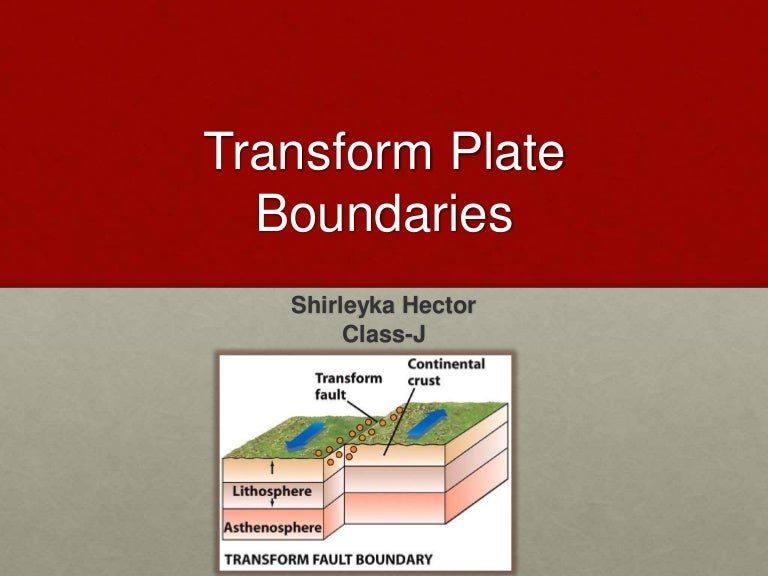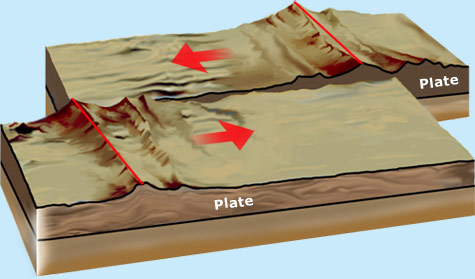

Right-lateral displacement and horizontal shortening occur across a zone 93 –125 mi (150 –200 km) wide. South of New Zealand, the Indo-Australian Plate is obliquely subducted beneath the Pacific Plate at the Puysegur Trench. North of New Zealand, the Pacific Plate is obliquely subducted beneath the Indo-Australian plate at the Tonga-Kermadec trench. The Alpine Fault Zone along the western South Island of New Zealand is an example of an obliquely convergent transform plate boundary separating two zones of subduction with opposite polarity. The lithosphere is thinner beneath the San Andreas fault system than for normal continental lithosphere. Other segments are undergoing slow, continuous deformation or creep.

In such segments, built-up strain may finally be rapidly released, producing an earthquake. Some segments of the San Andreas and other major faults in the San Andreas fault system are locked. Changes in their orientation and relay stepping of faults result in localized dilatation or contraction. The San Andreas Fault is the main transcurrent or strike-slip fault within a broad deformation zone that comprises hundreds of minor faults along western California. South of this triple junction, the Rivera Plate is subducted beneath North America. It terminates at the Rivera triple junction in the southern Gulf of California (junction between the Rivera, Pacific and North American plates).

#At transform plate boundaries series
The San Andreas fault system steps through a series of oblique spreading ridges and transform faults in the Gulf of California. The easterly moving Gorda –Juan de Fuca plate is subducted beneath the American plate north of the San Andreas fault system termination forming the Cascade Range. Here the North American and Pacific plates intersect the Gorda –Juan de Fuca plate. In the north, the San Andreas fault system terminates at the Mendocino triple junction where it intersects the Mendocino Fracture Zone and Cascadia subduction. Western California, part of the Pacific Plate, comprises exotic terranes translated northwards and rotated through angles up to 90 degrees along the margin of the North American plate. The northwards-moving Pacific plate is subducted at the Aleutian trench and at western Pacific island arcs. The best-known transform plate boundary is the San Andreas fault system, which accommodates the right-lateral displacement between the North American and Pacific plates. Take a ten question quiz about this page.A transform plate boundary is a margin between two lithospheric plates that constitutes a regional-scale transform fault. The Himalayan Mountains, including Mount Everest, were formed by the convergent boundary of the Indian Plate and the Eurasian Plate.Scientists are now able to track the movement of tectonic plates using GPS.The Pacific Plate is being subducted under the Mariana Plate. It is formed by a convergent boundary between the Pacific Plate and the Mariana Plate. The Mariana Trench is the deepest part of the ocean.It is the cause of so many earthquakes in California. It is the boundary between the North American Plate and the Pacific Plate. One famous transform boundary is the San Andreas Fault in California.These places are often called faults and can be areas where earthquakes often occur. Transform Boundaries - A transform boundary is one where two plates slide past each other.New land is formed by magma pushing up from the mantle and cooling as it reaches the surface. The area on land where the boundary occurs is called a rift. Divergent Boundaries - A divergent boundary is one where two plates are getting pushed apart.Here is a picture showing the major tectonic plates of the world. Some of the minor plates include the Arabian, Caribbean, Nazca, and Scotia plates.

The seven major plates include the African, Antarctic, Eurasian, North American, South American, India-Australian, and the Pacific plates. Most of the Earth is covered by seven major plates and another eight or so minor plates. Some of these plates are huge and cover entire continents. The lithosphere moves in big chunks of land called tectonic plates. The lithosphere is made up of the Earth's crust and a part of the upper mantle. The part of the land that is moving is the Earth's surface called the lithosphere. It takes millions of years for the land to move a significant amount. This movement is way too slow for us to notice, however, because it only moves between one to 6 inches per year. Although we think of the land on Earth as being fixed and stable, it turns out that it is constantly moving.


 0 kommentar(er)
0 kommentar(er)
